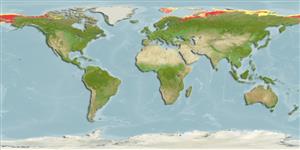Environment: milieu / climate zone / depth range / distribution range
Ecología
marino; agua dulce; salobre demersal; rango de profundidad 0 - 90 m. Polar; 82°N - 63°N, 12°E - 104°W (Ref. 117245)
Northeast Atlantic and Arctic: White Sea and Barents Sea eastward along the coasts of Siberia and North America to Queen Maud Gulf in Arctic Canada. North Pacific: Chukchi and Bering seas to Bristol Bay, Alaska and the northern Sea of Okhotsk.
Length at first maturity / Tamaño / Peso / Age
Maturity: Lm 17.0, range 15 - 18.9 cm
Max length : 44.0 cm TL macho / no sexado; (Ref. 58426); common length : 25.0 cm TL macho / no sexado; (Ref. 117245); edad máxima reportada: 26 años (Ref. 117245)
Espinas dorsales (total): 0; Radios blandos dorsales (total): 50-62; Espinas anales 1; Radios blandos anales: 35 - 44; Vértebra: 37 - 38. Distinguished by the presence of both eyes on the same side of the head, normal scales and generally plain coloration (Ref. 27547). Lateral line with a very low curve above pectoral fin, straight behind and with a short accessory branch on head; 73-76 pores on main portion; it is complete in males but in females as large as about 20 cm it is an open groove on the posterior part of the body (Ref. 10319). Most anterior dorsal ray above eye; anal with an embedded forward-pointing spine before first ray; caudal rounded (Ref. 27547). Eyed side dark olive green to brown, sometimes with scattered black dots or indefinite dark blotches; blind side white, rarely with brown lappings over from the eyed side; fins pale brownish, sometimes with a somewhat yellow tinge or traces of dark spots (Ref. 27547).
A coastal species not found far offshore (Ref. 27547). Occurs at shallow depths on mud bottoms, often in brackish water (Ref. 4705) and frequently entering freshwaters (Ref. 59043). Benthic (Ref. 58426). Feeds on small fishes and bottom invertebrates (Ref. 4705). Moves closer inshore in the evenings, especially on a rising tide (Ref. 27547). Appears to move offshore in the fall and inshore in the spring (Ref. 27547).
Reproduction cycle believed to occur only every second year (Ref. 27547).
Vinnikov, K.A., R.C. Thomson and T.A. Munroe, 2018. Revised classification of the righteye flounders (Teleostei: Pleuronectidae) based on multilocus phylogeny with complete taxon sampling. Molecular phylogenetics and evolution, 125:147-162. (Ref. 122998)
IUCN Red List Status (Ref. 130435)
Threat to humans
Harmless
Human uses
Pesquerías: escaso valor comercial
Más información
ReferenciasAcuiculturaPerfil de acuiculturaRazasGenéticaElectrophoresesheritabilidadEnfermedadesProcesamientoNutrientsMass conversion
Herramientas
Special reports
Download XML
Fuentes de Internet
Estimates based on models
Preferred temperature (Ref.
123201): -1.7 - 4.3, mean -0.1 °C (based on 2772 cells).
Phylogenetic diversity index (Ref.
82804): PD
50 = 0.7500 [Uniqueness, from 0.5 = low to 2.0 = high].
Bayesian length-weight: a=0.00437 (0.00285 - 0.00669), b=2.97 (2.84 - 3.10), in cm total length, based on LWR estimates for this species & (Sub)family-body (Ref.
93245).
Nivel trófico (Ref.
69278): 3.4 ±0.1 se; based on diet studies.
Resiliencia (Ref.
120179): Medio, población duplicada en un tiempo mínimo de 1.4-4.4 años (K=0.06; tm=2; Fec=31,000-230,000).
Fishing Vulnerability (Ref.
59153): High vulnerability (64 of 100).
Nutrients (Ref.
124155): Calcium = 29.4 [10.2, 55.1] mg/100g; Iron = 0.302 [0.119, 0.716] mg/100g; Protein = 16.3 [14.8, 17.8] %; Omega3 = 0.173 [0.069, 0.392] g/100g; Selenium = 10.9 [4.0, 31.6] μg/100g; VitaminA = 12 [2, 81] μg/100g; Zinc = 0.565 [0.334, 0.906] mg/100g (wet weight);
